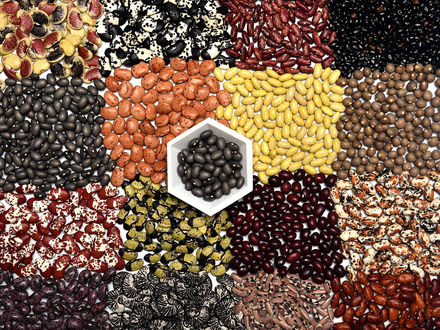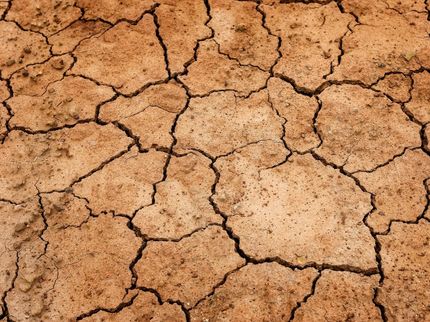Crop diversity is needed today for tomorrow’s food security and nutrition
Science can help mitigate, stem, and reverse loss of genetic diversity, for better productivity, resilience, and adaptive capacity in agriculture, a new study shows
Advertisement
Although scientists have been ringing bells for more than 100 years about the decline of crop diversity in agriculture, questions about the magnitude, causes, and significance of this loss remain unanswered.

Bean diversity at the CGIAR gene bank in Colombia.
Neil Palmer / CIAT
A team of 15 scientists from a wide range of research centers and universities set out 18 months ago to answer these persisting questions, resulting in the largest review ever conducted of evidence about change in crop diversity over time worldwide. The team reviewed hundreds of primary literature sources published over the last 80 years that examine potential crop diversity loss, also called “genetic erosion”. The global collaborative effort found that 95% of all studies reported diversity change, and almost 80% found evidence of loss.
Economic, agricultural, technological, climatic, and political changes during the last 100 years have together led to the decline or disappearance of diversity important to agriculture, both from cultivated fields and from wild habitats. Much of the crop diversity that remains continues to face the threat of erosion or even extinction, while also becoming more homogenous across local landscapes and around the world.
“The global picture that emerges from our review is that of enormous loss over a relatively short period of time of traditional agricultural diversity, which was nurtured by many cultures around the world over the last 10,000 years,” said lead author Colin Khoury, Senior Director for Science and Conservation at San Diego Botanic Garden and research scientist at the Alliance of Bioversity International and the International Center for Tropical Agriculture (CIAT). “Yet the picture also provides hope, as considerable crop diversity persists, and because it shows that agriculture can be re-diversified.”
Khoury collaborated with scientists at international and national agricultural research centers in the USA, Colombia, Germany, Italy, Mexico, and Peru, as well as universities including El Colegio de la Frontera Sur (Chiapas, Mexico), Ohio State University, Saint Louis University, the University of Arizona, the University of California at Davis, the University of Cambridge, and the University of Illinois to carry out the study, “Crop genetic erosion: understanding and responding to loss of crop diversity”, published in New Phytologist as a prestigious Tansley review. This review series was named after the famous English botanist and ecologist Arthur Tansley, who coined the term ecosystem in 1935.
Crop diversity is a critically important resource for agriculture and for human nutrition. This diversity keeps crops productive as they face pests and diseases, provides resilience during extreme weather and other shocks and offers the potential to adapt to changing climates and meet new market demands. In contributing to crop productivity and also to dietary diversity, it underpins food security and nutrition.
“The magnitude of crop diversity loss we have seen in some regions of the world underscores the importance of conserving this diversity outside of these ecosystems as well as within them,” said Luigi Guarino, Director of Science at the Crop Trust, and one of the study’s authors. ”Collections of crop diversity such as those in agricultural genebanks and botanic gardens can mitigate local and regional losses, enable the future reestablishment of diversity on farms, and preserve the availability of crops for future use by all. We need to strengthen these repositories and duplicate unique collections in other locations to insure against the risk of loss,” he said.
There are approximately 1,750 genebanks worldwide, maintaining over seven million samples of crop diversity, with botanic gardens, universities, nonprofits, community seed banks, and local conservation networks further contributing to ex-situ conservation. However, more work is needed to conserve the full range of diversity at risk of disappearing from farmers’ fields and, in the case of crop wild relatives, the wild progenitors and cousins of cultivated plants, from grasslands, forests and other natural habitats.
The study analyzed the change in the diversity of traditional crop varieties, or landraces, cultivated on farms; of modern crop cultivars in agriculture; of crop wild relatives in their natural habitats; and of crop genetic resources held in ex situ conservation repositories. The extent of change over time in these environments, while considerable, varied by crop, location, and analytical approach.
“The good news is that while we found evidence of enormous diversity loss over the past decades in each of the environments we studied, we also saw significant maintenance of that diversity in some contexts, and even marked increases in specific instances,” said Stephen Brush, second author for the study and Professor Emeritus of Human Ecology and former Master Adviser for International Agricultural Development at UC Davis.
Diversity of traditional crops remains high on farms and in gardens where landraces are valued for their unique agricultural and societal uses. One-third of the 139 studies of changes in traditional crop varieties reported the maintenance of this diversity over time, and almost one-quarter found evidence for the appearance of new diversity. Also, crop breeders have made significant strides toward diversifying modern crop cultivars in recent decades.
“For crop diversity to continue evolving alongside pests and diseases, in response to climate change, and to meet demands for improved crops that provide both economic products and ecological services, we need to redouble support for conservation efforts in situ, or in the field, as well as ex situ,” said co-author Allison Miller, Member and Principal Investigator at the Danforth Plant Science Center and Professor of Biology at Saint Louis University.
“In reviewing global change in the crop diversity that underpins everyone’s food security and nutrition, it’s obvious that there has been major loss, but also that the tools, methods, and knowledge exist to stop its further erosion,” said Khoury. “It is a matter of priorities and resources. To go a major step further and start to reverse the diversity trend, though, is a much bigger task. It requires no less than reframing our food systems, and even the societies they nourish, as diversity-supportive processes.”

































































